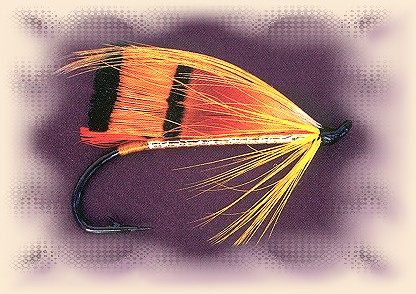Great Canadian Flies
Golden Girl

By Arthur James Lingren
From Fly Patterns of British Columbia, Published
by Frank Amato Publications.
We appreciate use permission.
During World War II, while Haig-Brown was away from steelhead
fishing, his thoughts repeatedly turned to what he considered
to be the make-up of the ideal winter steelhead fly pattern.
Believing that winter fish had a preference for reds and oranges,
he envisioned a fur, feather and tinsel combination much simpler
than, but similar to, the more elaborately dressed full-feather
winged Atlantic salmon flies such as the celebrated Durham
Ranger, Red Ranger, William Rufus, President, and the Red Sandy.
All of these patterns, with the exception of the Red Sandy, utilized
large golden pheasant tippet feathers for wings. The Red Sandy
too had whole-feather wings, but not golden pheasant tippet,
instead its brilliant red-orange winging consisted mainly of large
Indian crow feathers.
The pattern Haig-Brown developed was a combination of the slim-bodies
Red Sandy and the golden pheasant tippet-winged Durham Ranger without
many of the frills. In an 18 May 1949 letter to Al McClane of
Field & Stream magazine, Haid-Brown says that "the Golden
Girl - the one with tippets - is the final dressing and has proved
itself many times for winter steelhead."
Haid-Brown remained loyal to this dressing but with one slight
alternation: he substituted a golden pheasant crest feather,
often referred to as a topping, for the Indian crow tail
Almost two years later, in a January 1951 letter to a Seattle
fisherman, Haig-Brown says that the Golden Girl "is primarily
a winter steelhead fly, in sizes 2/0 to 2" and that he has "also
taken cutthroats and summer steelehad on it in sizes down to No.8."
The Golden Girl is an attractive pattern that catches the eye
of both the fly fisher and the fish. It is one of the oldies
that has survived the passage of time and can be found in
fly shops, particularly in the Campbell River area.
Details
Hook: Number 2/0 to 8.
Tail: A small Indian crow feather.
Body: Flat, gold tinsel.
Throat: Yellow hackle.
Wing: Two large golden pheasant tippet feathers back
to back, enclosing orange polar bear fur with a golden pheasant
topping overall.
Originator: Roderick Haig-Brown.
Intended Use: Wet fly for winter steelhead.
Location: Campbell River, B.C. Canada.
~ Arthur James Lingren
Credits: From Fly Patterns of British Columbia
by Arthur James Lingren. We thank
Frank Amato Publications, Inc. for use permission!
Our Man In Canada Archives
|

